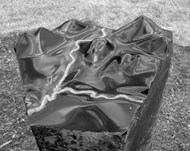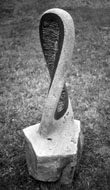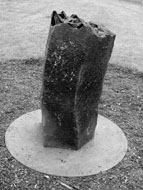With this article I hope to open up a discussion of the design ideas we use in our sculptures. I’ve chosen three of my pieces that are similar in approach as well as design. Decisions arising from materials, scale, and subject matter affect the form of a particular work before I begin actual design. Working primarily with granite and basalt, I can put sculptures outside where the public encounters them as part of their world rather than in a special “art” environment. I work in human scale, that is three to eight feet high, and frequently create pieces with a strong vertical axis rather than being horizontal or rounded. Viewers tend to respond physically and emotionally to such sculptures as if they were figures. I often refer to natural cycles: geological, biological, and human. I don’t intend to make literal representations, rather I depend on the power sculpture has to stimulate the observer’s own non-linear, non-verbal associations.
These considerations all came into play when designing ‘Snag’. It refers to a tree snag which, while at the end of its own life, generates further life by serving as a home and nursery for birds and wildlife. Although I occasionally do direct carving, ‘Snag’ is more typical in that I have a visual idea that I keep in my mind while developing the piece. I don’t work from drawings or maquettes, so the final design of the piece often changes during carving. A major means of seeing how the form would go as I laminated each stone was to visualize how the flow of energy would go up from the ground and through the tree.
As for the formal design elements, in addition to the vertical axis there is a helical movement around the axis both in the form itself and in the “bark” pattern. Besides mimicking a natural form, the diagonal of the helix gives a sense of movement around the piece and up from the earth to the sky. I used several different rocks in building a single form, both to emphasize stone moving through space rather than mass, and to create a sense of rhythm. It also allows me to involve construction as well as carving in making the sculpture.
I like to use several finishes to give visual variety to a work. To imply that the “tree” arises from the natural world I left the original texture of the base stone to contrast with the worked surfaces of the main sculpture. Pitched and bushed surfaces indicate stylized bark while the polished ends of the branches focus attention where the tree contacts the surrounding space.

In ‘Twisted Stele’ the helix dominates the form much more than in ‘Snag’. Again I use a variety of finishes: the original patina of the base section left to connect it to the earth, bushing on the transition from base to the helix and the outer edges of the helix, polish on the outer edges of the faces, and broken saw cuts meeting in the middle. The broken saw cuts have several functions: they activate what would be more uniform flat surfaces, they act in opposition to the upward flow of the helix, thus drawing the eye in toward the center of the sculpture, and they introduce the element of internal space into the work. This internal space visually connects the outside space to the interior. The delicacy of the connecting fragments gives a feeling of inner fragility in contrast to the outer strength.

‘Home’ is an example of a form dictated in large part by its concept. It portrays a section through the earth at the location of the Stillaguamish River valley where I live. Here I finally managed to do a vertical without a helical twist. However, the bend of the column creates a similar diagonal that adds to the feeling of upward movement as does the slight widening from bottom to top. The tension between the initial figurative aspect of the column and the miniature landscape it supports is intended as a “hook” to engage the passersby.
The highly polished topography plays off the rustic patina of the original basalt skin. This contrast serves to focus attention on the top which otherwise would appear truncated and create a sudden stop to eye movement. The reflective surface means viewers can see themselves as part of the sculpture.
The vertical scale of the valley shrinks as it moves up from the “river” to give more of a continuous flow from the valleys to the peaks. The rivers are marked by flaming with an oxyacetylene torch to give a vague, feathery appearance and then detailed with a point to give a white tool-mark contrast to the polished surface and natural weathered outside. A single dot shows location of my actual home. These details create a focal point that is important to the narrative of the work.
This discussion has touched on a particular set of ideas that appears in much of my work. Others that involve different design questions, or different permutations, could have been chosen; perhaps in another article.

